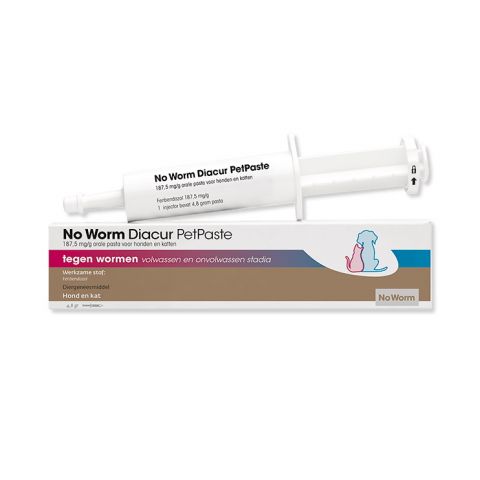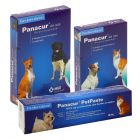Be the first to review this product
No Worm Diacur PetPaste | 4,8 grams
No Worm Diacur PetPaste
No Worm Diacur PetPaste is a paste for dogs and cats from 1 kg and is effective against the most common worm species: roundworms, whipworms (in dogs), hookworms and tapeworms. In addition, No Worm Diacur PetPaste works against the infectious Giardia parasite.
Active substance No Worm PetPaste
The active ingredient Fenbendazole kills roundworms, whipworms (in dogs), hookworms and tapeworms after administration. The deworming paste serves as a cure, which you should give for several consecutive days. The paste is easy to dose thanks to the handy adjustable dosing ring.
No Worm Diacur PetPaste contains the same active ingredient as Panacur worming paste.
How often should a dog or cat be wormed?
The ESCCAP (European Scientific Counsel Companion Animal Parasites) recommends deworming adult dogs and cats on average 4 times a year. Puppies deworm at 2, 4, 6 and 8 weeks of age, then every month until they are six months old. Kitten deworming at 3, 5 and 7 weeks of age, then every month until they are six months old.
Leaflet No Worm Diacur
For more information, and before use, read the leaflet.
No Worm Diacur PetPaste
No Worm Diacur PetPaste is a paste for dogs and cats from 1 kg and is effective against the most common worm species: roundworms, whipworms (in dogs), hookworms and tapeworms. In addition, No Worm Diacur PetPaste works against the infectious Giardia parasite.
Active substance No Worm PetPaste
The active ingredient Fenbendazole kills roundworms, whipworms (in dogs), hookworms and tapeworms after administration. The deworming paste serves as a cure, which you should give for several consecutive days. The paste is easy to dose thanks to the handy adjustable dosing ring.
No Worm Diacur PetPaste contains the same active ingredient as Panacur worming paste.
How often should a dog or cat be wormed?
The ESCCAP (European Scientific Counsel Companion Animal Parasites) recommends deworming adult dogs and cats on average 4 times a year. Puppies deworm at 2, 4, 6 and 8 weeks of age, then every month until they are six months old. Kitten deworming at 3, 5 and 7 weeks of age, then every month until they are six months old.
Leaflet No Worm Diacur
For more information, and before use, read the leaflet.
Leaflet No Worm Diacur PetPaste
No Worm Diacur PetPaste 187.5 mg/g oral paste for dogs and cats
NAME AND ADDRESS OF THE MARKETING AUTHORISATION HOLDER AND THE MANUFACTURER RESPONSIBLE FOR THE RELEASE, IF DIFFERENT
Marketing authorisation holder:
Intervet Nederland B.V.
Postbus 50
5830 AB Boxmeer
Netherlands
Manufacturer responsible for the release:
Intervet Productions S.A.
Rue de Lyons
27460 Igoville
France
DENOMINATION OF THE VETERINARY MEDICINAL PRODUCT
No Worm Diacur PetPaste 187.5 mg/g oral paste for dogs and cats
COMPOSITION OF ACTIVE AND OTHER INGREDIENTS
Per gram:
Active ingredient:
Fenbendazole 187.5 mg
Excipients:
Methyl-4-hydroxybenzoate (E 218) 1.7 mg
Propyl-4-hydroxybenzoate (E 216) 0.16 mg
White to light grey, smooth, spreadable, homogeneous paste.
INDICATION(S)
For the treatment of infections with gastrointestinal nematodes in kittens and adult cats, as well as in puppies and adult dogs. In dogs, additionally used as an aid in controlling the protozoan Giardia.
Kittens and adult cats:
Infection with the following gastrointestinal nematodes:
- Toxocara cati (adult stages)
- Ancylostoma tubaeforme (immature and adult stages)
Puppies and adult dogs:
Infection with the following gastrointestinal parasites:
- Toxocara canis (adult stages)
- Ancylostoma caninum (adult stages)
- Uncinaria stenocephala (immature and adult stages)
- Giardia spp.
CONTRAINDICATIONS
- Do not use in pregnant dogs until day 39 of pregnancy.
- Do not use in pregnant cats.
See also section 12 “Special warnings.”
SIDE EFFECTS
Occasionally, vomiting or mild diarrhea may occur in treated animals in relation to the deworming.
If you notice side effects, even if they are not mentioned in this leaflet, or suspect that the veterinary medicinal product is not effective, you are advised to inform your veterinarian.
TARGET ANIMAL SPECIES
Dog, cat.
DOSAGE FOR EACH TARGET SPECIES, ADMINISTRATION ROUTE, AND METHOD OF USE
Each syringe contains 4.8 g of paste, equivalent to 900 mg of fenbendazole. The plunger has 18 adjustable units, with each unit corresponding to 50 mg of fenbendazole. The desired number of units is obtained by rotating the dosing ring on the plunger.
One syringe of this veterinary medicinal product is suitable for animals weighing up to 6 kg. If the animal weighs more than 6 kg, more than one syringe should be used.
Adult cats:
The dose is 75 mg fenbendazole/kg body weight per day for 2 consecutive days.
A daily dose for 2 kg body weight corresponds to 3 units on the plunger. The dosing schedule is as follows:
Up to 2 kg body weight, 3 units daily for 2 days
2.1 to 4 kg body weight, 6 units daily for 2 days
4.1 to 6 kg body weight, 9 units daily for 2 days
etc.
The body weight of the animal to be treated should be determined as accurately as possible to calculate the required dose.
Kittens, puppies, and adult dogs:
The dose is 50 mg fenbendazole/kg body weight per day for 3 consecutive days.
The dosing schedule is as follows:
1.0 to 2 kg body weight, 2 units daily for 3 days
2.1 to 3 kg body weight, 3 units daily for 3 days
3.1 to 4 kg body weight, 4 units daily for 3 days
4.1 to 5 kg body weight, 5 units daily for 3 days
5.1 to 6 kg body weight, 6 units daily for 3 days
etc.
Especially in cases of heavy contamination, the elimination of Ancylostoma tubaeforme in adult cats, Giardia spp. in dogs, and ascarids in puppies and kittens may be incomplete, leaving a potential risk of infection for humans. A fecal examination should therefore be carried out, and based on the results, a repeat treatment should be given if necessary, according to the veterinarian's judgment.
INSTRUCTIONS FOR CORRECT ADMINISTRATION
Remove the cap from the syringe and turn the ring until the upper edge is level with the 0 to prepare the syringe for the first use. Press the plunger and remove any paste that comes out of the syringe. The syringe is now ready for use. The plunger has 18 adjustable units, with each unit corresponding to 50 mg of fenbendazole. Determine the required number of units based on the animal's body weight. Rotate the plunger ring to the corresponding unit.
Administer this veterinary medicinal product directly into the mouth after feeding by placing the paste from the syringe on the back of the tongue.
The paste can also be mixed with the food.
WITHHOLDING PERIOD(S)
Not applicable.
SPECIAL STORAGE PRECAUTIONS
Keep out of the sight and reach of children.
Store below 25°C.
Do not use this veterinary medicinal product after the expiry date stated on the label and carton. The expiry date refers to the last day of the month.
Shelf life after first opening the syringe: 28 days.
SPECIAL WARNINGS
Special warnings for each target species:
Resistance of parasites to a particular class of anthelmintics can develop after repeated use of an anthelmintic from that class.
Special precautions for use in animals:
Since the accuracy of dosing is limited, the veterinary medicinal product should not be administered to kittens and puppies weighing less than 1 kg.
Special precautions to be taken by the person administering the veterinary medicinal product:
Avoid, as far as possible, direct skin contact.
Wash hands after use.
Persons with known hypersensitivity to the active substance or any of the excipients should avoid contact with the veterinary medicinal product.
Pregnancy and lactation:
Dog:
Do not use in pregnant dogs until day 39 of pregnancy.
This veterinary medicinal product may be used for the treatment of pregnant dogs during the last third of pregnancy. However, since teratogenic effects caused by the fenbendazole metabolite oxfendazole cannot be completely excluded in rare cases, this use should only take place according to the benefit/risk assessment by the attending veterinarian.
Cat:
Do not use during pregnancy.
This veterinary medicinal product may be used in lactating dogs and cats.
Overdose (symptoms, emergency procedures, antidotes):
In dogs, after treatment with 3 times the recommended dose or for 3 times the recommended treatment duration, a transient induction of lymphoid hyperplasia in the gastric mucosa may be observed. These findings have no clinical relevance.
In cats, no treatment-related adverse effects were observed after overdose with the same dosing schedule.
SPECIAL PRECAUTIONS FOR THE DISPOSAL OF UNUSED VETERINARY MEDICINAL PRODUCTS OR WASTE MATERIALS
Any unused veterinary medicinal product or waste material should be disposed of in accordance with local requirements.
DATE OF LAST REVISION OF THE PACKAGE LEAFLET
January 21, 2022
OTHER INFORMATION
Cardboard box containing 1 or 10 syringes.
Not all pack sizes may be marketed.
| Animal | Dog, Puppy, Cat, Kitten |
| Prescription required Netherlands | No |
| Prescription required Germany | |
| Prescription required France | |
| Prescription required Spain | |
| Further information |




